
|
Sale 24
Manuscript and Collectibles Auction
| Lot |
Photo |
Description |
Realized |
Lot 675 |
 |
Recently Discovered Sinohydrosaurus. China, 125 million yeards old. This rather new reptile, the Sinohydrosaurus Lingyuanensis, was found in Lingyuan, Liaoning Province, in northeast China, and formally described and named only in 1999. Here we see it curved in its death throes, bedded in a manganese spotted limestone. Sinohydrosaurus was neither a fish nor an amphibian. In the manner of the present day whale or dolphin, it was a reptile that descended from a land-dwelling ancestor to become a fresh-water dweller. This creature looks very similar to the Keichousaurus, but is smaller, different in structure and a much newer creature, by about 100 million years, than the Keichousaurus. Length: c. 20". Matrix: 19-1/2" x 9-3/8". Weight: 4.5 pounds. Rare.
Estimated Value $600 - 850.
View details and enlarged photo
| Unsold |
Lot 676 |
 |
Spinach-Green African Malachite. A magnificent 23-pound chunk of malachite measuring about 9 x 8 in. by about 5 in. high, its surface entirely covered on top and sides (and partially on the bottom), with brilliant spinach-green clusters of "cauliflower" malachite. The regularity of the clusters, the deep bewitching color, and the natural glossiness imparted by nature, not polishing, combine to render this a one-in-a-million collector's treasure. From Zaire.
Estimated Value $400 - 600.
View details and enlarged photo
| Unsold |
Lot 677 |
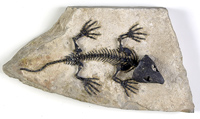 |
Splendid Display of Captorhinus Aguti. Oklahoma, 280 Million years old. Displayed on the shale matrix it was recovered from, the re-articulated bones are laid out to show its wide, splay-footed stance. The skeleton is a dark brown on the buff colored stone. From the Arroyo formation near Lawton, Oklahoma, this is one of the first reptiles to appear in the fossil record. It was a plant eater and had a light-sensitive gland at the top of its brain. On the skull is a small hole over where the gland would have been, and light would thus filter through skin and tissue to strike the brain. This animal would have been ancestral to both the subsequent dinosaurs and mammals. Length: 11-1/4". Matrix: 14-3/4" x 8". Weight: 10 pounds. The skull loose, and can either be laid over the neck, or re-attached to the vertebrae. Choice and rare.
Estimated Value $2,250 - 2,750.
View details and enlarged photo
| Realized
$2,530 |
Lot 678 |
 |
Triceratops Rib Bones, 70 Million Years Old. Triceratops is one of the most famous dinosaurs, known for its distinctive horns. Even though there are a number of partial skulls and horns known, there are no complete skeletons known, and other bones from Triceratops are quite rare. Consequently, these three well-preserved rib bones from an adult Triceratops present a rare opportunity to acquire a museum-quality dinosaur display at a modest price.
These three curved rib bones are 19-21 inches long along the curve and remain intact in the red limestone matrix as found in the Hell Creek Formation of Montana. They are 65-70 million years old. It is rare to find even one intact dinosaur bone, but finding three attached rib bones is very rare indeed. An outstanding display fossil for any dinosaur enthusiast. Weight is 17½ pounds.
Estimated Value $750 - 1,250.
View details and enlarged photo
| Realized
$546 |
Lot 679 |
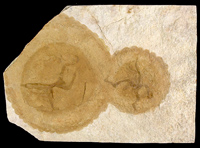 |
Two Huge Early Cambrian Medusoid Jellyfish. Jellyfish are one of the earliest multicellular life forms, but are extremely rare in the fossil record because they bare no hard parts to fossilize.When they are found, they are usually small, only 1 to 3 inches in diameter and also very faint in detail.
These two jellyfish are the rare exception in being both very large, 12 and 7 inches in diameter, as well as incredibly detailed, being a brown to dark brown in color, contrasted against a light hard sandstone matrix. These jellyfish have scalloped edges and convex central bell centers. When these Cnidarian medusoids were trapped in a shallow tidal pool, probably as a result of a storm, they pumped their bell, trying to escape. This resulted in the "stomach" and internal cavity filling with sand. The exact age of these huge jellyfish is still being determined, being from 545 to 520 million years old. From Central Wisconsin Mount Simon sandstone. Weight is 29½ pounds.
Estimated Value $650 - 1,200.
View details and enlarged photo
| Unsold |
Lot 680 |
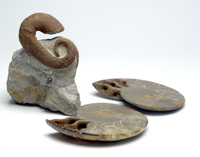 |
"Type" Set Of Three Differently-Shaped Ammonites. Ammonites are ancient cephalopods related to the present-day squid and octopus, but with hard shells protecting their tentacled bodies. This interesting lot has a type set of the three major shapes of ammonites and nautiloids.
Nautiloids started out with completely straight shells such as this 10 inch long, 100 million year old specimen of Baculites compressus from Montana. These delicate fossils are almost never found complete, but this sizeable specimen is missing only 3 to 4 inches of the portion that would taper to a point. Excellent suture patterns show along with some of the original mother-of-pearl which has remineralized to shades of tan with iridescent splashes of green still partially embedded in its original, very hard stone matrix.
A traditionally-shaped 5 inch diameter polished ammonite from Madagascar (Perisphinctes species). Over 150 million years old from the Jurassic period, it has been cut in half and polished to show the internal chambers. The individual chambers are defined and filled with calcite crystals. In life, each chamber was added one at a time, as the ammonite grew in age. The outer surface shows excellent sutures and flashes of red and green mother-of-pearl.
A 3¼ inch Heteromorphic ammonite (Ancyloceras) from Morocco. This 100 million year old dark brown ammonite has been artistically positioned on its stone matrix in a 3-D floating position. Heteromorphic ammonites started to spiral, straightened out, and then curved again. There is also a bonus 2 inch spiral ammonite on the back of this stone base. Total weight is 9 pounds.
Estimated Value $500 - 900.
View details and enlarged photos
| Unsold |
Lot 681 |
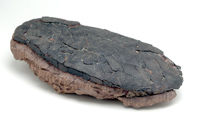 |
Tyrannosaurus Bataar Egg. A museum quality, complete, flattened egg, 14 x 6½ inches, with nearly 100% of the original shell, cracked but intact, with beautiful dark brown color on a red limestone base. The Tyrannosaurus eggs are both the largest and rarest of all dinosaur eggs. They are so rare because Tyrannosaurs did not travel in herds like most other dinosaurs and laid their eggs in isolated nests. This beautiful egg comes from the Henan Province, China. Tyrannosaurus Bataar is a cousin of Tyrannosaurus Rex from North America. There are no known eggs from a T-Rex. Virtually all of these huge eggs are hatched and flattened and are usually found with only 30-50% of their original shell. Very rare. Weight is 13½ pounds.
Estimated Value $2,500 - 3,500.
View details and enlarged photo
| Realized
$3,220 |
Lot 682 |
 |
Very Rare Triceratops Nose Horn. Almost everybody is familiar with Triceratops horidus, with its two long horns on its head, as well as a horn on its nose. Even though it is very popular, no complete skeleton has ever been found. Whole skulls cost upwards of $100,000, so the few brow horns and even fewer nose horns, when available, are eagerly sought after by both museums and collectors.
This medium brown nose horn, from the Hell Creek Formation in Wyoming, is 10 x 17 inches and virtually complete. A Triceratops horn had a bone core that was covered by keratin, the same substance that makes up our fingernails, which would make them about one third longer. The bone of this nose core shows the light furrows on its surface, which represent blood-flow areas in a living Triceratops. This is an opportunity to own a rare and significant dinosaur fossil from the last era of dinosaurs, some 65-67 million years ago in Wyoming. Weight is 8 pounds.
Estimated Value $2,750 - 3,500.
View details and enlarged photo
| Realized
$2,185 |
Lot 683 |
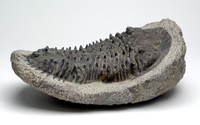 |
Very Rare, Large, Spiked Trilobite. Everyone knows trilobites as small, 1 or 2 inch black bugs, but some were much larger and much more interesting. This rare trilobite--Burmeisterella, from Morocco--is not represented in any museum. It is large at 9 inches long and 5 inches wide, and strange with 2 stalked eyes and its entire body covered with sharp spikes to prevent predation. Burmeisterella is over 375 million years old and is one of the oddest trilobites from the Devonian seas of Morocco. Similar specimens have sold for more than $3,000 at auction. Weight is 12 pounds.
Estimated Value $850 - 1,650.
View details and enlarged photo
| Unsold |
Lot 684 |
 |
Weird Armored Fish - 380 Million Years Old. The very first fish looked nothing like the fish of today. Many of them had armor to protect them from predators, lived on the sea bottom, and were poor swimmers. This weird looking 13 inch armored fish (Coccosteus cuspidatus) was excavated from the old red sandstone strata on Cokney Island, Scotland. The head and body of Coccosteus was covered by armored bone and, although crushed, is still present on this very rare fossil. Only the tail was free of this heavy armor. The six inch long tail is fully present and intact, which is unusual. The brown armor and tail are highly contrasted on the hard black slate of this large and rare early fish. There are no fish in the ocean today that look anything like these early fish. An amazing Devonian fish, rarely offered for sale. Weight is 11½ pounds.
Estimated Value $1,000 - 1,850.
View details and enlarged photo
| Unsold |
Lot 685 |
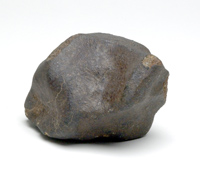 |
Whole Stony Meteorite, Juancheng, From China. Although most meteorites that fall to earth are stony meteorites, whole intact stony meteorites are rarely encountered since most finds consist of a single meteorite weighing a few pounds at most. Meteorites are named after the city or region where they fall and collector demand is so high to own a piece of a named fall that the meteorite found is usually cut up and polished to satisfy this demand. Also, the fusion crust (the burned, brown to black thin outer layer fro the intense heat of passage through the atmosphere) quickly weathers away and thus makes it difficult to identify a meteorite.
This 680 gram specimen (4½ x 3 inches) has over 90% of its original dark brown fusion crust with a few areas missing that show its internal structure high in iron and chondrules, which are small, near spherical, silicate grains that were part of the interstellar cloud that condensed to form all the plants, moons, and asteroids.
This meteorite fell to earth on February 15, 1997, on farmland near the Yellow River in the Shandong Province of China. The large stony meteorite (called an ordinary chondrite) exploded 8-10 miles above the surface, resulting in most recovered specimens being quite small. This 1¼ pound specimen is one of the larger pieces available of the recent Juancheng meteorite that was believed by the Chinese to portend the death of the sick Chairman Deng Xiao Peng, who died several days after this meteorite fell.
Estimated Value $950 - 1,500.
View details and enlarged photo
| Realized
$1,150 |
|
|